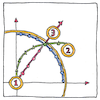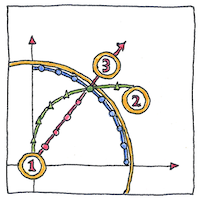Gaspard-Gustave de Coriolis
atmospheric_sciences

|
Coriolis effect
The earth moves, the atmosphere has mass, it would all appear as Newton described except for the fact that everything is rotating. Whirl around with a ball at the end of a string and it will seem to pull away from you. This is called the centrifugal effect, which isn’t really a force, but the effect of subtracting the direction of spin from the ball’s inertial trajectory. Similarly, the Coriolis effect makes an object moving on a straight path but in a rotating field of reference appear to swerve against the direction of the spin. * The earth is a spinning sphere so winds and currents appear to veer.
Handedness
If you stand on the north pole, the earth turns counterclockwise; if you stand on the south pole, it turns clockwise. A great circle between points at the same latitude above the equator arches to the north; but below the equator arches to the south. The Coriolis effect pulls wind and currents to the right when north of the equator and to the left when south.
Unhandy
If I don’t think carefully first, left and right come out at random, it seems, even though I know which direction to turn. But thinking isn’t easy, nor is it easy to remember to think. I often need to think first about needing to.



You tell me why the Coriolis effect pulls to the right in the northern hemisphere but to the left in the southern. I often mix up left and right. A demonstration or animation would be useful.
See also in The book of science:
Readings in wikipedia: